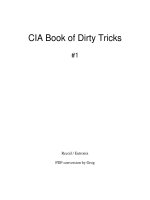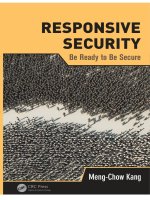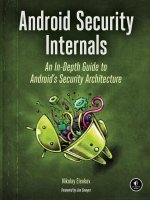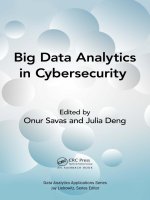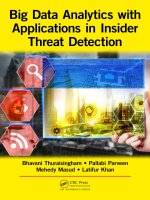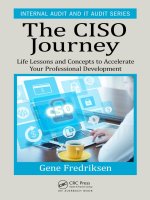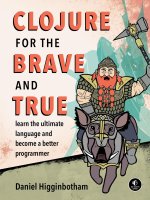Hacking ebook cisojourney
Bạn đang xem bản rút gọn của tài liệu. Xem và tải ngay bản đầy đủ của tài liệu tại đây (5.54 MB, 317 trang )
The CISO Journey
Life Lessons and Concepts to Accelerate
Your Professional Development
Internal Audit and IT Audit
Series Editor: Dan Swanson
A Guide to the National Initiative
for Cybersecurity Education (NICE)
Cybersecurity Workforce Framework (2.0)
Dan Shoemaker, Anne Kohnke, and Ken Sigler
ISBN 978-1-4987-3996-2
A Practical Guide to Performing
Fraud Risk Assessments
Mary Breslin
ISBN 978-1-4987-4251-1
Corporate Defense and the Value
Preservation Imperative:
Bulletproof Your Corporate
Defense Program
Sean Lyons
ISBN 978-1-4987-4228-3
Data Analytics for Internal Auditors
Richard E. Cascarino
ISBN 978-1-4987-3714-2
Fighting Corruption in a Global
Marketplace: How Culture, Geography,
Language and Economics Impact Audit and
Fraud Investigations around the World
Mary Breslin
ISBN 978-1-4987-3733-3
Investigations and the CAE:
The Design and Maintenance of an
Investigative Function within Internal Audit
Kevin L. Sisemore
ISBN 978-1-4987-4411-9
Internal Audit Practice from A to Z
Patrick Onwura Nzechukwu
ISBN 978-1-4987-4205-4
Leading the Internal Audit Function
Lynn Fountain
ISBN 978-1-4987-3042-6
Mastering the Five Tiers
of Audit Competency:
The Essence of Effective Auditing
Ann Butera
ISBN 978-1-4987-3849-1
Operational Assessment of IT
Steve Katzman
ISBN 978-1-4987-3768-5
Operational Auditing: Principles and
Techniques for a Changing World
Hernan Murdock
ISBN 978-1-4987-4639-7
Securing an IT Organization through
Governance, Risk Management, and Audit
Ken E. Sigler and James L. Rainey, III
ISBN 978-1-4987-3731-9
Security and Auditing of Smart Devices:
Managing Proliferation of
Confidential Data on Corporate
and BYOD Devices
Sajay Rai, Philip Chukwuma, and Richard Cozart
ISBN 978-1-4987-3883-5
Software Quality Assurance:
Integrating Testing, Security, and Audit
Abu Sayed Mahfuz
ISBN 978-1-4987-3553-7
The CISO Journey:
Life Lessons and Concepts to Accelerate
Your Professional Development
Gene Fredriksen
ISBN 978-1-138-19739-8
The Complete Guide to
Cybersecurity Risks and Controls
Anne Kohnke, Dan Shoemaker,
and Ken E. Sigler
ISBN 978-1-4987-4054-8
Cognitive Hack: The New Battleground in
Cybersecurity ... the Human Mind
James Bone
ISBN 978-1-4987-4981-7
The CISO Journey
Life Lessons and Concepts to Accelerate
Your Professional Development
Gene Fredriksen
CRC Press
Taylor & Francis Group
6000 Broken Sound Parkway NW, Suite 300
Boca Raton, FL 33487-2742
© 2017 by Taylor & Francis Group, LLC
CRC Press is an imprint of Taylor & Francis Group, an Informa business
No claim to original U.S. Government works
Printed on acid-free paper
International Standard Book Number-13: 978-1-138-19739-8 (Hardback)
This book contains information obtained from authentic and highly regarded sources. Reasonable efforts
have been made to publish reliable data and information, but the author and publisher cannot assume
responsibility for the validity of all materials or the consequences of their use. The authors and publishers
have attempted to trace the copyright holders of all material reproduced in this publication and apologize to copyright holders if permission to publish in this form has not been obtained. If any copyright
material has not been acknowledged please write and let us know so we may rectify in any future reprint.
Except as permitted under U.S. Copyright Law, no part of this book may be reprinted, reproduced, transmitted, or utilized in any form by any electronic, mechanical, or other means, now known or hereafter invented, including photocopying, microfilming, and recording, or in any information storage or
retrieval system, without written permission from the publishers.
For permission to photocopy or use material electronically from this work, please access www.copyright
.com ( or contact the Copyright Clearance Center, Inc. (CCC), 222 Rosewood
Drive, Danvers, MA 01923, 978-750-8400. CCC is a not-for-profit organization that provides licenses and
registration for a variety of users. For organizations that have been granted a photocopy license by the
CCC, a separate system of payment has been arranged.
Trademark Notice: Product or corporate names may be trademarks or registered trademarks, and are
used only for identification and explanation without intent to infringe.
Library of Congress Cataloging‑in‑Publication Data
Names: Fredriksen, Gene, author.
Title: The CISO journey : life lessons and concepts to accelerate your professional
development / Gene Fredriksen.
Description: Boca Raton, FL : CRC Press, 2017.
Identifiers: LCCN 2016043407 | ISBN 9781138197398 (hb : alk. paper)
Subjects: LCSH: Chief information officers. | Computer security. | Computer
networks--Security measures. | Data protection.
Classification: LCC HF5548.37 .F735 2017 | DDC 658.4/78--dc23
LC record available at />Visit the Taylor & Francis Web site at
and the CRC Press Web site at
Contents
List of Figures.................................................................................................xi
List of Tables................................................................................................ xiii
Prologue......................................................................................................... xv
Foreword.......................................................................................................xix
Acknowledgments.........................................................................................xxi
Author........................................................................................................ xxiii
Section I INTRODUCTION AND HISTORY
1 Introduction: The Journey.......................................................................3
2 Learning from History?...........................................................................5
3 My First CISO Lesson: The Squirrel.......................................................9
The Big Question: How Did I End Up in Info Security?............................10
Section II THE RULES AND INDUSTRY DISCUSSION
4 A Weak Foundation Amplifies Risk......................................................15
Patching: The Critical Link….....................................................................19
It’s about More Than Patching....................................................................21
Patching Myth One...............................................................................21
Patching Myth Two...............................................................................22
Patching Myth Three.............................................................................22
Patching Myth Four...............................................................................22
Scanning Required!....................................................................................23
Misconception One................................................................................23
Misconception Two................................................................................24
Misconception Three..............................................................................24
Misconception Four...............................................................................24
Misconception Five................................................................................25
Environment Control.............................................................................26
Tracking IT Assets.................................................................................26
v
vi ◾ Contents
Risk Management..................................................................................27
Key Questions to Ask.............................................................................33
5 If a Bad Guy Tricks You into Running His Code on Your
Computer, It’s Not Your Computer Anymore........................................39
Worms, Trojans, and Viruses: What’s in a Name?......................................41
Myth One..............................................................................................41
Myth Two............................................................................................. 42
Myth Three........................................................................................... 42
Myth Four.............................................................................................43
Myth Five...............................................................................................43
Myth Six............................................................................................... 44
Myth Seven........................................................................................... 44
Myth Eight............................................................................................45
Myth Nine.............................................................................................45
Myth Ten (and My Personal Favorite)................................................... 46
Attack Types Are Wide-Ranging............................................................... 46
Social Engineering......................................................................................47
6 There’s Always a Bad Guy Out There Who’s Smarter,
More Knowledgeable, or Better-Equipped Than You............................49
What about Your People?............................................................................56
Plan for the Worst.......................................................................................58
Not All Alerts Should Be Complex.............................................................61
What about Wireless?.................................................................................61
Context-Aware Security..............................................................................63
Suggested Reading..................................................................................... 64
7 Know the Enemy, Think Like the Enemy..............................................65
Monitoring What Leaves Your Network Is Just as Important as
Monitoring What Comes In: Introducing the “Kill Chain” Methodology....73
Stack the Deck in Your Favor.....................................................................78
Picking the Right Penetration Test Vendor.................................................79
How Should Penetration Testing Be Applied?.............................................79
Selecting a Vendor......................................................................................80
8 Know the Business, Not Just the Technology........................................83
The Role of Risk Management within the Enterprise................................. 84
Separation of Duties...................................................................................86
Is There an Overlap between Legal, Compliance, and Human Resources?.... 90
A Model Structure......................................................................................91
Risk Management/Organizational Management Interaction......................92
Executive Steering Committee...............................................................93
Information Security Officer Committee...............................................93
Contents ◾ vii
Information Security Department Staffing.................................................94
The Compliance Arm of the CISO Office..................................................96
Security Operations and Engineering.........................................................96
User Access and Administration.................................................................97
Advice for the New CISO...........................................................................98
Tying Your Goals and Objectives to Company Goals...............................101
Conclusion................................................................................................102
9 Technology Is Only One-Third of Any Solution..................................103
Let’s Look at Risk Management and the People, Process,
and Technology Methodology..................................................................104
Safe Harbor Principles..............................................................................106
Prevent.................................................................................................109
Detect.................................................................................................. 110
Respond............................................................................................... 110
Recover................................................................................................112
10 Every Organization Must Assume Some Risk.....................................115
No Is Seldom the Answer......................................................................... 117
Strive for Simplicity..................................................................................120
Risk Planning Is Just as Important as Project Planning............................121
Dealing with Internal Audit.....................................................................125
The Work..................................................................................................127
11 When Preparation Meets Opportunity, Excellence Happens.............129
End-User Training and Security Awareness..............................................130
Flashback to High School Memories… ....................................................132
Training Methods.....................................................................................132
New Hire Training...................................................................................133
Awareness Seminars..................................................................................135
Security Policy..........................................................................................143
Roles and Responsibilities.........................................................................144
Company Board and Executives...........................................................144
Chief Information Officer.................................................................... 145
Information Technology Security Program Manager........................... 145
Managers.............................................................................................. 145
Users....................................................................................................146
Formal Training.......................................................................................147
Brown Bag Lunches..................................................................................147
Organizational Newsletters.......................................................................148
Awareness Campaigns...............................................................................148
Tests and Quizzes.....................................................................................149
Funding the Security Awareness and Training Program...........................149
Summary..................................................................................................150
viii ◾ Contents
12 There Are Only Two Kinds of Organizations: Those That Know
They’ve Been Compromised and Those That Don’t Know Yet............155
Loss Types................................................................................................ 158
Consequences of Loss............................................................................... 158
How Can DLP Help?............................................................................... 158
Prevention Approach................................................................................ 159
PCI DSS Credit Card Guidelines......................................................... 159
Guidelines............................................................................................160
Credit Card Processing Procedures...................................................... 161
Employee Loyalty Is a Factor....................................................................162
What Can You Do?..................................................................................167
13 In Information Security, Just Like in Life, Evolution Is Always
Preferable to Extinction......................................................................169
Security Strategic Planning.......................................................................171
The Planning Cycle...................................................................................172
Foundation/Strategy.................................................................................172
Assessment and Measurement...................................................................172
Key Risk Identification.............................................................................173
Develop the Strategic Plan........................................................................ 174
Process Inputs......................................................................................175
Money, Money, Money… ....................................................................179
Capital Expenditures.......................................................................179
Operational Expenses......................................................................179
14 A Security Culture Is In Place When Talk Is Replaced with Action......181
Introduction............................................................................................. 181
Training....................................................................................................183
Basics........................................................................................................185
Technology...............................................................................................187
Data Security............................................................................................188
Productivity..............................................................................................190
Communication.......................................................................................192
E-mail.......................................................................................................195
Morale......................................................................................................196
Metrics and Measures...............................................................................197
Workplace.................................................................................................198
Conclusion............................................................................................... 200
15 NEVER Trust and ALWAYS Verify.....................................................203
Trust Your Vendors: Home Depot............................................................207
Nervous about Trusting the Cloud?..........................................................209
Does Your System Encrypt Our Data while They Are Stored
on Your Cloud?....................................................................................210
Contents ◾ ix
Does the Provider Have a Disaster Recovery Plan for Your Data?........210
Don’t Confuse Compliance with Security............................................ 211
Has the Potential Vendor Earned Certifications for Security
and Compliance That Can Provide Assurance of Their Capabilities?.... 211
What Physical Security Measures Are in Place at the Supplier’s
Data Centers?.......................................................................................212
Where Are My Data Being Stored?......................................................212
Vendor Oversight Program Basics.............................................................213
Internal Trust...........................................................................................213
Section III SUMMARY
16 My Best Advice for New CISOs...........................................................221
Talking to the Board.................................................................................223
Appendix A: The Written Information Security Plan..................................225
Appendix B: Talking to the Board...............................................................241
Appendix C: Establishing an Incident Response Program..........................253
Appendix D: Sample High-Level Risk Assessment Methodology................273
Index............................................................................................................279
List of Figures
Figure 1.1 Threat cycle.......................................................................................4
Figure 4.1 Elements versus functions...............................................................17
Figure 4.2 Support life cycle............................................................................19
Figure 4.3 Patching..........................................................................................20
Figure 4.4 OSI layers.......................................................................................25
Figure 4.5 Risk matrix.....................................................................................29
Figure 6.1 My dad invents “defense in depth”.................................................50
Figure 7.1 What the bad guys want..................................................................69
Figure 7.2 Rising sophistication.......................................................................70
Figure 7.3 Attack frequency.............................................................................72
Figure 7.4 Kill chain........................................................................................75
Figure 8.1 Balance...........................................................................................86
Figure 8.2 Risk versus organizational pressures................................................87
Figure 8.3 Risk management organization.......................................................91
Figure 8.4 Information Security Executive Council.........................................93
Figure 8.5 Information Security Officer Committee........................................94
Figure 8.6 Office of the Chief Information Security Officer............................95
Figure 8.7 RACI..............................................................................................99
Figure 8.8 Program goals...............................................................................102
Figure 9.1 People, technology, process...........................................................108
Figure 9.2 Resiliency......................................................................................109
xi
xii ◾ List of Figures
Figure 9.3 Controls versus risk areas..............................................................113
Figure 10.1 Risk versus means....................................................................... 117
Figure 10.2 Risk versus means (2).................................................................. 119
Figure 10.3 Keep it simple.............................................................................121
Figure 11.1 Awareness poster.........................................................................148
Figure 13.1 Security strategy..........................................................................173
Figure 13.2 Security plan............................................................................... 174
Figure 13.3 Compliance program goals......................................................... 176
Figure 13.4 Investment priorities...................................................................177
Figure 13.5 Impact versus effectiveness..........................................................178
Figure A.1 Business continuity.......................................................................237
Figure B.1 Board engagement........................................................................247
Figure B.2 Board framework..........................................................................248
Figure B.3 Cost of a breach............................................................................251
Figure C.1 CSIRT organization chart............................................................259
Figure C.2 Notification process.....................................................................261
Figure C.3 Six stages of CSIR....................................................................... 264
Figure C.4 Incident RACI.............................................................................270
Figure D.1 Risk assessment............................................................................274
Figure D.2 Risk assessment matrix................................................................277
List of Tables
Table 15.1 Trust............................................................................................. 215
Table 15.2 Trust with value............................................................................ 215
Table C.1 Security level classifications............................................................267
Table C.2 Contact information..................................................................... 268
Table D.1 Overall risk....................................................................................278
xiii
Prologue
Gaining Wisdom along the Journey
Ask anyone in the cybersecurity industry and they’ll tell you that there’s a staggering shortage of talent entering the field. This is happening at a time when information security is more critical than ever before in underpinning the successful and
ongoing business operations of organizations everywhere.
As we continue to experience a relentless succession of cyberattacks unleashed
on both private- and public-sector organizations, government and executive leaders alike are becoming increasingly aware of just how crucial their information
security postures are to their mere subsistence. Standing at the forefront of the
charge to make cybersecurity initiatives a way of life for businesses everywhere are
the professionals who are tasked with not only trying to thwart current or future
onslaughts but also identifying a throng of vulnerabilities within their infrastructures that could lead to additional attacks or result in penalties against their companies because of noncompliance with a bevy of industry and government mandates.
These and still other problematic information security issues, such as the adoption by organizations of the newest technologies or the ever-changing ways people
engage with businesses today, which are all rife with weaknesses and appealing
attack surfaces, have spurred a desperate need for organizations to employ qualified
information security professionals at every level—from IT security analysts and
architects to risk and compliance directors to Chief Information Security Officers
(CISOs). Such practitioners have far-reaching roles that must see them build, maintain, and continuously update holistic risk management and compliance strategies
and day-to-day tactics that account for internal- and external-facing operations and
policies.
In other words, cybersecurity and privacy needs are acutely evident to growing
numbers of professional leaders and everyday citizens. Yet, the resources, budget,
and qualified practitioners required to adequately address these apparent necessities
remain disproportionate to the assortment of today’s security challenges. Perhaps,
too, the basic understanding of what now is essentially a condition of not only
conducting business but also simply living day to day is still being lost on some
xv
xvi ◾ Prologue
individuals and groups who are poised to set powerful examples of how cybersecurity must be integrated into pretty much every aspect of our lives.
According to a recent study undertaken by Intel Security in partnership with
the Center for Strategic and International Studies, 76% of corporate IT leaders
involved in cybersecurity decision-making who participated in the research said
their respective governments are failing to invest enough in building specialized
talent. Based on interviews with some 900 IT decision-makers from organizations
with at least 500 employees situated in a range of countries (including the United
States and seven others), a meager 23% said educational programs are actually preparing students to enter the industry. More than half stated that the cybersecurity
skills shortage is worse than those faced by other IT professions.
Yet the scarcity of qualified pros has become a more prominent political focal
point for some in the last couple of years, prompting the likes of our own President
Obama and other countries’ leaders to urge greater support for the information
security field and its professionals’ growth and development. Even with a few promising proposals underway, however, they couldn’t happen soon enough given that
about 70% of the research participants said the current talent shortage is causing
direct, measurable harm to their networks. In fact, one in four admitted that their
businesses have lost proprietary or critical data because of the dearth of cybersecurity skills on hand within their organizations.
What’s needed, they explained further, is some hearty on-the-job training,
which takes precedent over a mere university degree, though individuals looking
for a role in their companies must have formal educational credentials to garner
any serious consideration. Also, more vigorous continuous education, engaging
instructional opportunities and nontraditional methods of learning, such as handson exercises, hackathons, and more, likely would prove an additional boost to
strengthening the talent pool.
In this regard, information security industry conferences and events—especially
those boasting more varied and practical learning experiences—have become more
vital and, as a result, well attended by seasoned pros and newbies alike. For Gene
Fredriksen, these gatherings are a pretty decent barometer in revealing how the
industry is changing and what long-time, more-seasoned leaders like him, a group he
calls “the first generation of CISOs,” can do to help it continue to thrive and evolve.
Mentoring, as he notes in the following pages of this book, is a main component
crucial to the ongoing development of this marketplace and the people in it. And
this happens not only at a variety of industry events, but also is critical on the job.
“As I move further into my career, my focus is on evangelism and helping to
drive the overall profession further. Part of that is helping peers explain complex
issues clearly to the E-suite (executive suite),” he explained to me in an e-mail
exchange last year. “It’s all about passing the torch and leaving things better as the
first generation of CISOs begins to retire.”
He called out some signs of this metamorphosis when attending one of the
longest-standing industry events, the RSA Conference, last year. As he looked
Prologue ◾ xvii
around at others hitting the show, he remembered thinking: “When did they start
allowing 12-year-olds on the exhibit floor? I can’t believe I got my first full-time
infosec job in 1989.”
But it’s that experience starting in the field right when it was only at the extreme
early stages of any real, well-formed profession that has enabled him to pick up
many a lesson along the way, study with varied and experienced mentors, make and
learn from mistakes, hone and grow his technical and leadership skills, and develop
and refine a robust information security philosophy. Enlisting all this know-how,
he has found himself over the years establishing and managing both cybersecurity
plans and departments for global organizations that often had neither when he
started there. Really, as an infosec pioneer, his own vocational beginning was just
as fledgling as the cybersecurity industry itself; he played an indispensable role
alongside others like him to drive and mold what it meant to create, propel, and
oversee an information security strategy and the teams and divisions supporting it.
After I met Gene around 2003 or so, he asked that I come to St. Petersburg,
Florida, to participate in a conference he had organized at the long-standing
financial services company Raymond James where he worked at the time as the
company’s first CISO. The roster was stellar, having other leading industry practitioners like him speaking alongside cybersecurity specialists from the likes of the
FBI, DHS, and others. That I was asked to participate was an honor, especially
given that our first engagement was impelled by a disagreement over some topic or
another that I covered in one of my commentaries. Gene recalls contacting me with
his differing thoughts.
“The following month, you put a follow-up [in another commentary] saying
that Gene Fredriksen of Raymond James didn’t completely agree with your views
and passed them along. Shortly after that we talked and it’s been a great relationship ever since,” he recalls.
And it has. His professionalism, thoughtfulness, and combination of both technical prowess and business acumen saw his career blossom over the years. From
Raymond James, he moved to IT industry research and analysis company Burton
Group, which was acquired by Gartner in recent years, to become one of their
leading industry analysts. After that, he was off to security systems giant Tyco
International where he created their global cybersecurity strategy and division,
thereby helping to advance the security of both internal operations and external
product offerings. And, currently, he is CISO for financial services firm PSCU,
which provides both traditional and online assistance to more than 800 credit
unions. All the while, he has contributed columns to SC Magazine and scmagazine
.com, spoken at our events—both live and online, participated on our Editorial
Advisory Board, and been a cover story subject who shared his thoughts on threat
intelligence gathering and kill chain processes to support information security
strategies and initiatives. More than that, though, he has provided much-welcome
guidance to me as my team and I navigated the industry to ensure that our brand
was always improving and always meeting the needs of CISOs like him.
xviii ◾ Prologue
Mentoring—not only does he advocate it in the pages of this book, but he
engages in it every single day with folks like me, his staff, colleagues, and, of course,
his own kids. And he reminds us all that we should embrace opportunities to guide,
educate, and welcome both new talent, whether they’re just starting their careers
or making transitions from others, to continue driving the overall industry, the
profession itself, and ourselves ever forward.
“Much of what we do as CISOs or security professionals is based on our experiences and the lessons we have learned over the years,” he states in his introduction
to this book. “Mentorship is a critical part of the development of our skills.”
He couldn’t be more accurate. And what he provides here in The CISO Journey
are outcomes from some of those learning moments he has experienced over his
career, the challenges along the way that helped him to continue to progress professionally and personally, and the “rules of information security” that he has modified from peers or shaped and sharpened himself. Infused with a little humor along
the way—because seeing the laughable side of situations is a trait that can soften
even some of the hardest blows dealt to us all, Gene now presents to you all of his
rules, industry best practices, and sage counsel to aid you on your own journey.
Illena Armstrong
VP, Editorial, SC Magazine
Illena Armstrong is VP, Editorial of SC Magazine, the leading business magazine
for the information security industry, where she manages editorial staff in New
York and Michigan. She is responsible for overseeing the award-winning monthly
publication and its many other editorial offerings, including scmagazine.com, the
SC Magazine Canada monthly digital editions, numerous eConferences, webcasts,
newsletters, and physical events in the United States and Canada, and more. She
has spoken and moderated at a number of industry events, including SC World
Congress, SC Congress Canada, SC Magazine Roundtables, the RSA Conference,
the Techno Security Conference, and others. On her watch, SC Magazine has won
more than 20 awards, including Magazine of the Year 2009, from the American
Society of Business Publication Editors (ASBPE). Before her stint at SC Magazine,
she worked for various newspapers and magazines in New England and the southern United States.
Foreword
Security is a complex subject and an equally complicated problem to solve. Volumes
have been written on the subject, much of which has a rather short half-life given
the rapid change in technology and the creativity of the adversaries we face. Sir
Alfred J. Ayer (1910–1989), a noted English philosopher, once said, “There never
comes a point where a theory can be said to be true. The most that one can claim
for any theory is that it has shared the successes of all its rivals and that it has passed
at least one test which they have failed.” So it is with approaches to security. There
is no absolute solution, just incrementally better ones.
What Gene Fredriksen has offered us is not so much a technical discourse on
security but rather a common sense approach to security based on his years of experience. He offers approaches that can lead to better solutions and enhanced security.
As Gene once explained to me, “Never get into a fight without the data to back you
up.” This sage and simple advice has helped me throughout the years. It is common
sense that many leaders of today seem to lack or have erroneously supplanted with
technology. Common sense is far more enduring than technology though evidently
more difficult to acquire.
What Gene presents is a sort of Ockham’s Razor for security. Another way to
sum it up is it reflects the KISS principle: keep it simple, stupid. Anyone who has
worked with Gene knows how he avoids complexity, which has served him and
the companies he has worked for well. There are no precise answers offered in this
book to the myriad challenges you may face in your security role. It is more like the
irrational numbers Pi or Phi that offer no precision yet present elegance in their very
existence and application to real world problems.
Richard D. Lanning, Jr., PhD
Planear, LLC
xix
Acknowledgments
With special thanks to:
Richard Lanning, PhD: His help was instrumental in the creation of this book.
His ethics, analytical skills, and industry knowledge are a great asset to the
company and me personally. I value his friendship and counsel.
Illena Armstrong, SC Magazine VP and Editor: She has been a longtime source
of support and advice.
Pamela Fredriksen, my wife: Her support and love have kept me “shiny side
up” during this journey. There were many late nights and long trips over the
years and she has always been there for me.
Heather, Jeff, Holly, and Joe, our four children: They have kept life interesting
and rewarding for me. Thanks for your support and inspiration.
Kathy Simpson: Her graphics skills are amazing. Thank you for your invaluable help.
Deborah Kobza, CEO of the Global Institute for Cyber Security and Research:
A longtime friend and peer who has influenced my career.
David Bryant, Information Security Officer, PSCU: He has worked with me
at many companies over the last 16 years. Thank God he is patient and long
suffering.
Lori Lucas, Head of Technology Compliance for PSCU: She has also been a
longtime friend and advisor.
Rini Fredette, Enterprise Risk Officer for PSCU: A great peer and an expert in
the area of Enterprise Risk.
Lee Carpella: Instrumental in the editing of this book.
Larry Clinton, CEO of the Internet Security Alliance: An expert in the Cyber
Security Industry and Regulatory space. Larry is a great friend and advisor.
Richard Jacek: He was my first official mentor in industry. I still use many of
the skills he taught me today.
xxi
xxii ◾ Acknowledgments
Brad Anderson: A longtime friend and associate who has helped me shape my
views of technology and the world.
Chuck Fagan, CEO of PSCU: If there was a template for a Security Aware
CEO, it would be Chuck.
Michael Echols, CEO of the International Association for Certified ISAOs:
Mike is an exceptional resource given his broad range of private sector and
government experience.
Israel Martinez, CEO of Axon: A mentor and friend for many years.
Author
Gene Fredriksen, Chief Information Security Officer at PSCU, is responsible for
the company’s development of information protection and technology risk programs. Gene has more than 25 years of information technology experience, with
the last 20 focused in information security. In this capacity, he has been heavily
involved with all areas of audit and security. Before joining PSCU, Gene held the
positions of CISO for Tyco International, principal consultant for Security and
Risk Management Strategies for Burton Group, vice president of Technology Risk
Management and chief security officer for Raymond James Financial, and information security manager for American Family Insurance. Gene is a distinguished
fellow with the Global Institute for Cyber Security and Research, located at the
Kennedy Space Center. He is also the executive director of the newly formed
National Credit Union Information Sharing and Analysis Organization. He was
the chair of the Security and Risk Assessment Steering Committee for BITS,
and served on the R&D committee for the Financial Services Sector Steering
Committee of the Department of Homeland Security. Gene is a distinguished fellow for the Global Institute for Cyber Security and Research, headquartered at the
Kennedy Space Center. Gene is a member of the SC Magazine Editorial Advisory
Board and was named one of three finalists for the SC Magazine CISO of the
Year Award in 2015. He served as chair of the St. Petersburg College Information
Security Advisory Board and the Howard University Technology Advisory Board.
He is a member of multiple advisory boards for universities, organizations, and
security product companies. Gene attended the FBI Citizens Academy and maintains a close working relationship with both local and federal law enforcement
agencies.
xxiii
